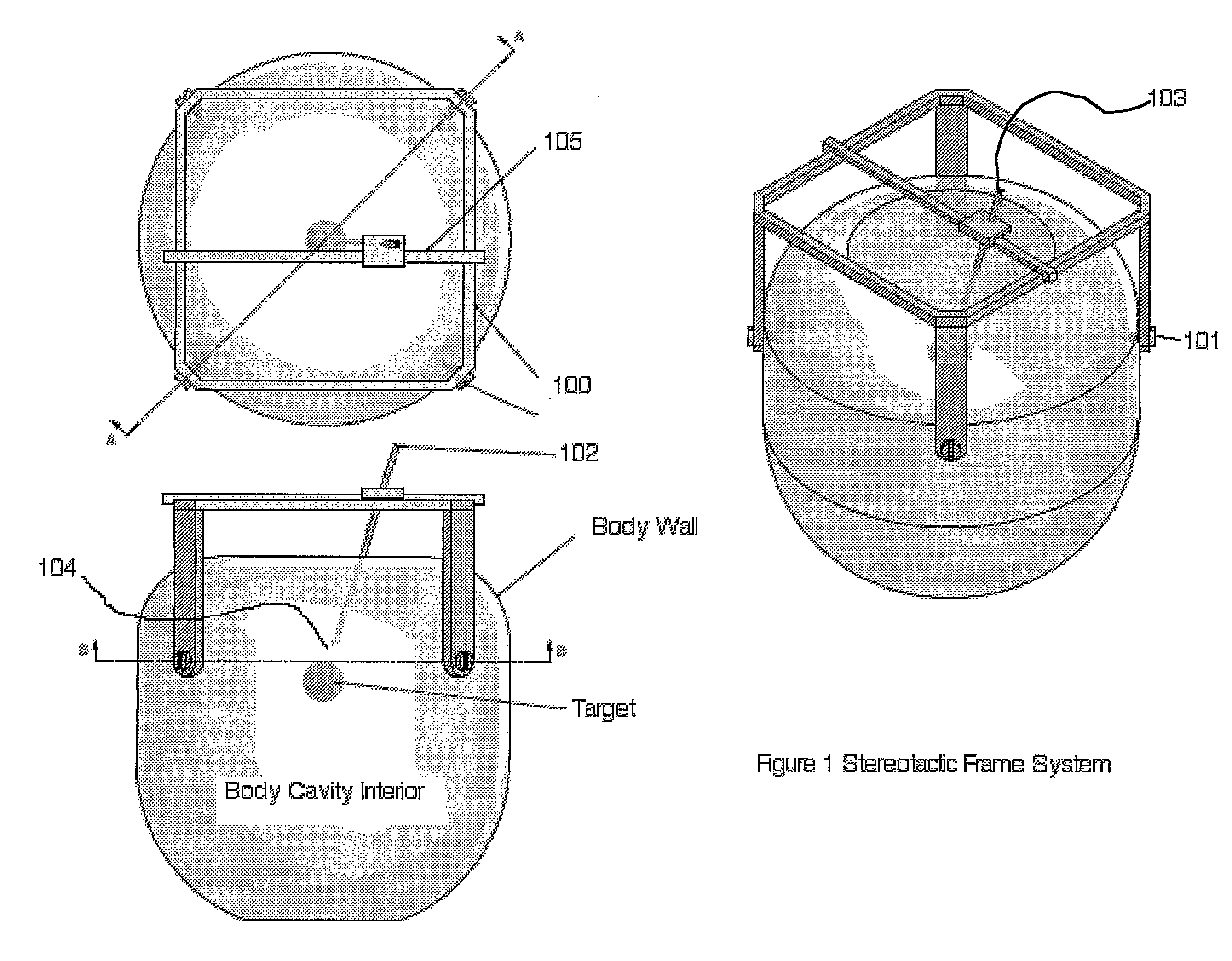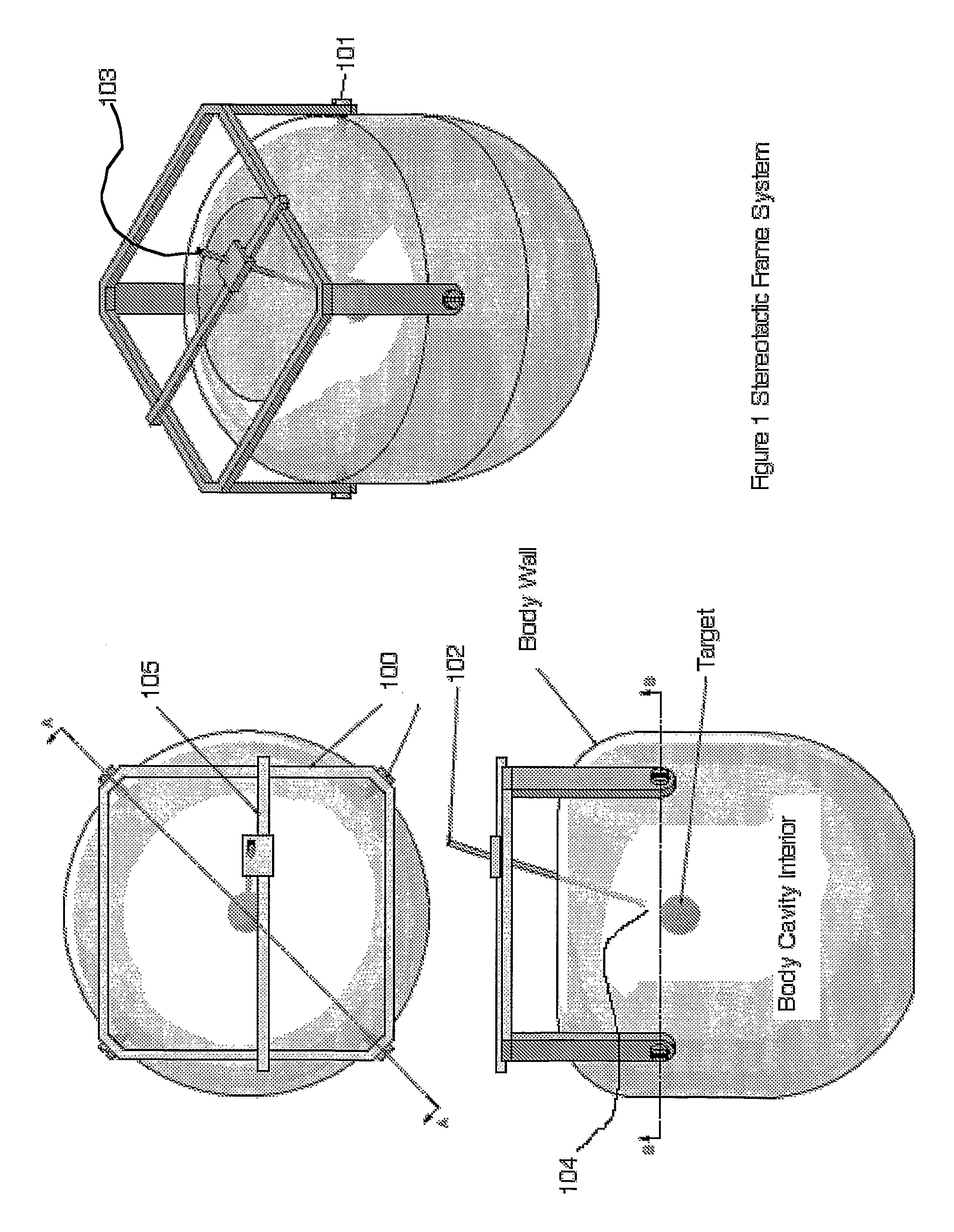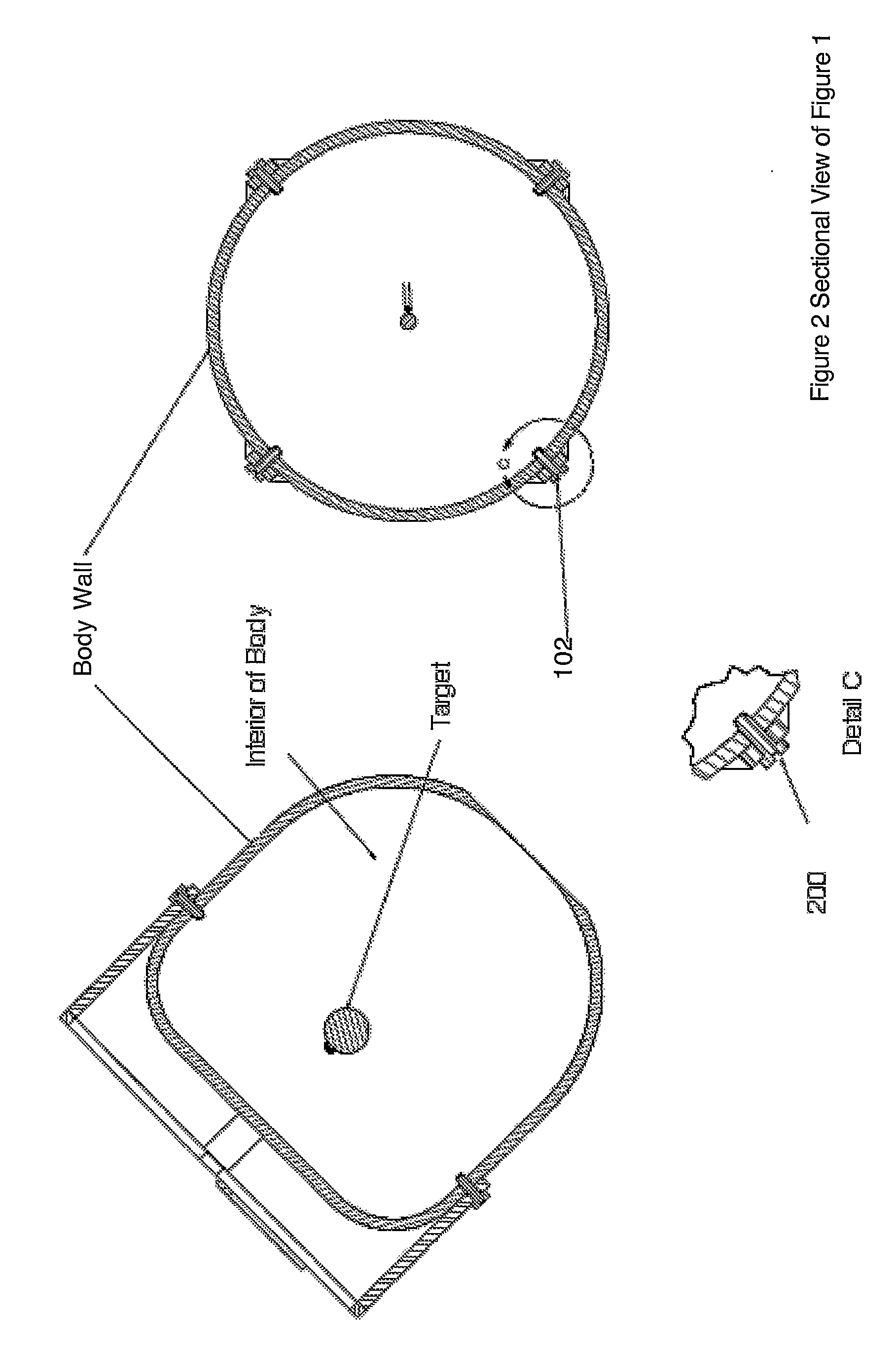[0005]We describe methods and apparatus that will enable accurate targeting and placement of a medical or surgical implement (tool) using two-dimensional or three-dimensional as required
real time imaging of the body interior and thereby minimize risks to the patient. The methods include means to introduce imaging and other sensor transducers across the body wall in an accurate, clean and safe fashion. These methods significantly minimize, or eliminate, the introduction of air or other extraneous substances into the body while performing these procedures. Pressure differentials and changes across the body wall during invasive procedures are controlled and minimized. As a result there is minimal or no shift in the internal organs dimensions and positions within the body. This increases the accuracy of targeting, produces less damage to non-targeted tissue and reduces
risk of infection. The apparatus and methods are related to transducers assemblies placed through the
body cavity wall for
real time imaging and other
data acquisition, means to control the pressure differential between the body cavity and the
atmosphere to limit
distortion of the internal organs upon opening of the body cavity and control of
contamination of the internal body cavity, imaging techniques to combine the now less distorted real-time image with pre-procedural images, and, medical or surgical tool placement effectors for accurate placement that make use of these improved real time images. Each aspect of the invention may offer improvement in medical or
surgical procedures in its own right. When combined the apparatus and methods provide a singularly significant improvement in medical and surgical techniques.INDUSTRIAL APPLICABILITY
[0010]4) Placement of depth electrodes for diagnosis of
epilepsy: This involves the accurate placement of recording electrodes in specific areas within the brain to localize areas that generate seizures.
[0015]Any displacements that occur despite the use of the pressure regulating environments described here can be measured with the real time imaging and comparison across time with multiple images. Such comparison and accurate measurement of displacement will allow corrections to be applied to the stereotactic calculations and allow accurate targeting. Another situation in which these methods will advance current stereotactic techniques is when the
intracranial pressure is raised (e.g. Brain tumors, intracranial bleeds,
hydrocephalus, etc.). In this
scenario, stereotactic procedures are fraught with the risk of brain herniation through the holes placed on the
skull because the
intracranial pressure exceeds
atmospheric pressure. Our techniques will allow access to the brain in such a situation and allow decompression of the increased
intracranial pressure in a graduated fashion such that an acute herniation of the brain can be avoided by controlling the pressure differential between the brain and
atmosphere.
[0016]As a specific example, in patients with brain tumors that bleed and cause raised intracranial pressures, taking a sample of the
brain tumor to decide
treatment options is critical. In this
scenario, stereotactic techniques that are in current use are fraught with serious danger of herniation of the brain during the procedure through the hole placed on the
skull. The proposed methods will correct this issue because the hole is covered by membranes that control the
pressure threshold across the
skull. Thus, we can
biopsy the
brain tumor safely and then if necessary decompress the
brain tumor and the bleed within the tumor
bed such that the pressure differential can be gradually reduced. Thus the adaptive sealing device we describe here in conjunction with the real time
multimodality imaging, 3D mapping of the brain and on line ability to correct trajectory will allow accurate targeting of diagnostic and therapeutic interventions in the brain and any other stereotactically accessed body part which has a
differential pressure in comparison to
atmospheric pressure without loss of precision of targeting and changes in pressures. The method of imaging presented here can be extended to assessment of the state of the brain.
[0017]The hollow screw assemblies and special
transducer assemblies provide access points into the body. The screw assemblies and
transducer assemblies are designed such that transducers are interchangeable with other transducers and with other devices. This is further enabled by the means for
controlled atmosphere and pressure The transducers may monitor intracranial structure, pressure, volume, temperature, pulsitility and
chemical composition of the internal structures. In addition, the hollow screw assemblies will serve as access points to the application of cortical stimulators for electrical, magnetic, pharmacological or other modalities of stimulation. These hollow screw assemblies will also allow delivery of medications,
radiation and other modalities of treatment. When 2 or more hollow screw assemblies are applied to the body they could be used together in such a fashion that one is used to deliver substances into the body and another to remove substances from the inside. Using the same principle, one or more of the hollow screw assemblies could be used to deliver substances or remove substances while others are used to monitor changes inside the body. Examples of such uses include decompression of a brain tumor using
chemotherapy applied directly to the tumor
bed while the debris from such applications is removed via the same application hollow screw
assembly or other screw assemblies. The state of the brain in terms of volume and pulsatility and also its
biochemical composition then may be monitored by the other screw assemblies. Another example would be the effects of
brain trauma monitored in a field hospital. It is well known that
brain trauma can lead to
brain swelling and the constraints of the skull causes the swelling of the brain to remain restricted in space resulting in severe damage to the brain itself. By the application of the hollow screw assemblies in the battle field, soldiers who sustain head injuries or in an emergency ambulance in the case of civilians who sustain head injuries in
road traffic accidents, the status of
brain swelling can be accurately monitored. Furthermore, such monitoring will determine if additional imaging is necessary so that patients can be triaged on the severity of
brain trauma. The hollow screw
assembly will thus serve as a window to monitor, treat or diagnose dysfunction within the cranium.
[0019]In conjunction with the application of hollow screw assemblies, conventional trans-cranial
ultrasound procedures via an orbital, temporal or occipital window could be used to monitor therapeutic interventions inside the cranium. For example, trans-cranial
ultrasound procedures can be used to determine the location and size of the
substantia nigra as has been previously described. This
landmark will then be used for targeting interventions into neighboring structures like the sub-thalamic
nucleus during interventional procedures (e.g.
deep brain stimulation). Such trans-cranial
ultrasound procedures exams could also be combined with the ultrasound information obtained through the hollow screw
assembly application. Thus, such trans-cranial ultrasound procedures and
percutaneous transcranial ultrasound obtained through the hollow screw assemblies could be combined and co-registered. Such co-registered data could help monitor overall
brain function after the removal of the hollow screw assemblies using trans-cranial ultrasound procedures alone.
 Login to View More
Login to View More  Login to View More
Login to View More 


